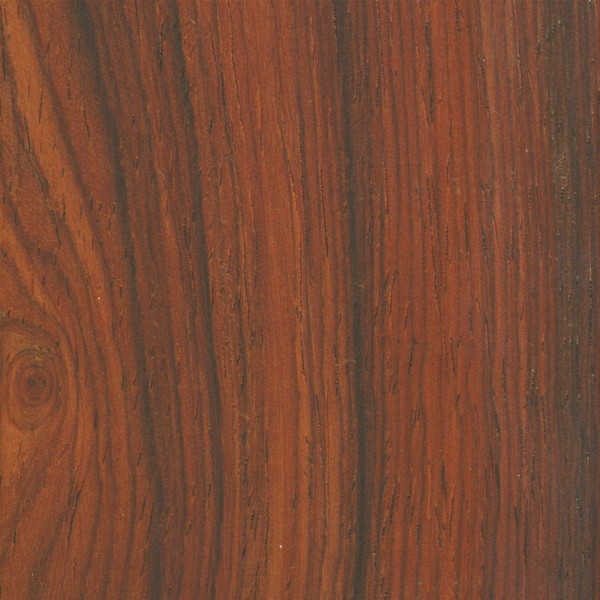Cocobolo
Color/Appearance: Cocobolo can be seen in a kaleidoscope of different colors, ranging from yellow, orange, red, and shades of brown with streaks of black or purple. Sapwood is typically a very pale yellow. Colors are lighter when freshly sanded/cut, and darken with age; for more information, see the article on preventing color changes in exotic woods.
Grain/Texture: Grain is straight to interlocked, with a fine even texture. Good natural luster.
Endgrain: Diffuse-porous; medium to very large pores in no specific arrangement, very few; solitary and radial multiples of 2-3; various mineral deposits occasionally present; parenchyma diffuse-in-aggregates, vasicentric, and marginal; rays narrow, fairly close spacing.
Rot Resistance: Rated as very durable, and also resistant to insect attack. Its natural oils are reported to give it good resistance to degrade from wet/dry cycles.
Workability: Due to the high oil content found in this wood, it can occasionally cause problems with gluing. Also, the wood’s color can bleed into surrounding wood when applying a finish, so care must be taken on the initial seal coats not to smear the wood’s color/oils into surrounding areas. Tearout can occur during planing if interlocked grain is present; the wood also has a moderate blunting effect on cutting edges/tools due to its high density. Cocobolo has excellent turning properties.
Odor: Cocobolo has a distinct spice-like scent when being worked, which some find unpleasant: though it has been used in at least one women’s perfume.
Sustainability: This wood species is in CITES Appendix II, and is on the IUCN Red List. It is listed as vulnerable due to a population reduction of over 20% in the past three generations, caused by a decline in its natural range, and exploitation.
Common Uses: Fine furniture, musical instruments, turnings, and other small specialty objects.
Comments: One of today’s most prized lumbers for its outstanding color and figure; yet also one of the most infamous for its difficulty in gluing, and its tendency to cause allergic reactions in woodworkers.
Also, there are a few misleading reports of Cocobolo’s Janka hardness being only about 1,100 lbf, and it’s modulus of elasticity at only about 1,100,000 lbf/in2: which is almost certainly either a typo or a different wood than what is commonly called Cocobolo (Dalbergia retusa). Reports indicate that Cocobolo is stronger and denser than Brazilian Rosewood, and that is the basis for the strength values (bending strength and modulus of elasticity) that are quoted at the top of this page.
Specific gravity is used to predict the hardness of wood with a fair degree of accuracy, and given its incredibly high density, (it sinks in water: see video below), Cocobolo’s hardness (and other strength properties) is most likely several times higher than the 1,100 lbf which is sometimes reported.



